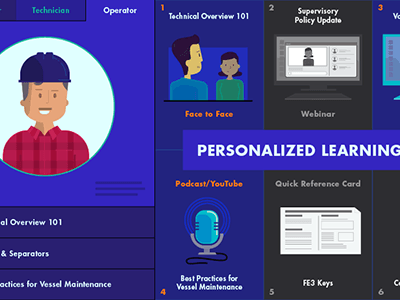Boosting ROI requires either lowering costs or improving return. These 4 key blended learning strategies can help you do both.

1. Be Choosy – Select Blended Learning Delivery Models and Methods To Achieve Both Higher Impact and Lower Cost
The essence of blended learning design is breaking a course down to its elements, then selecting the best blend of delivery methods to balance development and delivery cost (investment) with performance improvement (return). This granularity of elements means that instead of having to build a course that is either a flagship or a tugboat, you can design a course like a fleet, which deploys flagships only where needed and uses barges and tugs, and even inner tubes to do the jobs they fit better. The key is making good decisions about which blended learning model and delivery methods will work best. Good analysis resulting in a fit for design learning offers a big payoff.
2. Cut To The Chase – Minimize Time Spent On Anything Besides High-Impact Learning, For Both Learners and Instructors
Leverage Expert Instructors’ Time Up Front
Leverage expert instructors’ time up front to help develop sample eClips, videos, and other materials that capture their knowledge in learning-friendly forms. Once developed, these focused materials can be accessed anytime by learners on the job or in classes taught by someone with less expertise, without requiring the expert instructor’s presence or attention each time.
Minimize Travel Time and Cost
Minimize travel time and cost, then minimize more. With any blended learning model, you have already reserved classroom Instructor-Led Training (ILT) to those parts of courses where simultaneous, centralized, face-to-face interactions are absolutely necessary. Consider virtual ILT to further reduce travel cost. The affordability and availability of VILT technology now make this a viable option. With VILT, you can effectively train a growing and more dispersed population at a lower cost, while still offering the human element. VILT allows learners to ask questions, express views, participate in discussions, and get trained together irrespective of location. Successful VILT requires the seamless interplay of 3 important factors: technology, content, and delivery.
Alternatives to classroom-based ILT include:
- Instructor-led webinars with interactive activities and learning games
- Web-based training (WBT)
- Learners interview experts at their own job site (face to face) or other locations (video interview), then report back to the class on their interview or practice task (online forum with peer and instructor interaction)
- Social media mentorship programs to provide peer support, as Christopher Pappas discusses in his article on improving online training ROI
3. Create Once, Use Often – Repurpose Content To Touch Learners Many Times Without Reinventing The Wheel
Design new blended learning content or repurpose existing content to be multi-use and multi-modal. This allows you to touch learners more than once with the same high-quality content via multiple delivery methods, as they need it, over time, extending training into just-in-time performance support. Reusing content leverages the initial development investment for a lower cost per use. Multiple exposures to content reinforce learning, which improves retention and performance, thereby improving return.
Examples:
- Infographics used to orient learners before class, as a reference during class, and as refreshers
- Microlearning software demos excerpted from longer WBTs, available as online help back on the job
4. Streamline Access – Make Accessing Content Clear and Easy For Learners
One of the most common problems that drive down ROI is users not being able to find what they need, or not being sure what they’ve found is accurate and applies to them. Barriers to learning include:
- Overstuffed LMSs where learners can’t discern the current and relevant from the outdated and irrelevant (example: nine variations on a “Management of Change” course)
- Content chunks are so big that learners can’t find specific answers (examples: a four-hour or even forty-hour course with no indexing or tagging to jump to micro-topics; a 30-minute course with locked navigation, forcing the learner to go through the entire course again to review a particular topic)
- Materials are scattered across many different places, so learners don’t know where to look or it takes too long to find what they need
- Robust but difficult to search intranets
Sometimes, the move toward blended learning can actually make this problem worse because blended learning by definition has multiple parts. It is imperative to organize this multiplicity to serve learners, not overwhelm them.
Try This: Personalized Learning Maps
Give users personalized learning maps to guide them through all the elements in a course (or career) that are relevant to them.
Try This: Create a Learning Portal
A learning portal provides a one-stop, reliable access point for aggregated, curated, searchable learning content. It can sit on top of an LMS, or replace it if your needs are fairly basic. Either way, it can track who takes which courses. It is organized around the learner’s needs, so finding current, accurate content is easy, and learners can be confident they’ve found the right content for them.

Key Strategic Takeaways
Remember, to put yourself ahead of the pack in boosting your corporate training ROI:
- Be choosy about your blended learning model to make it fit for purpose.
- Cut to the chase and minimize low-impact time and content.
- Create once, use often to touch learners many times with repurposed content.
- Streamline access to learning portals.







